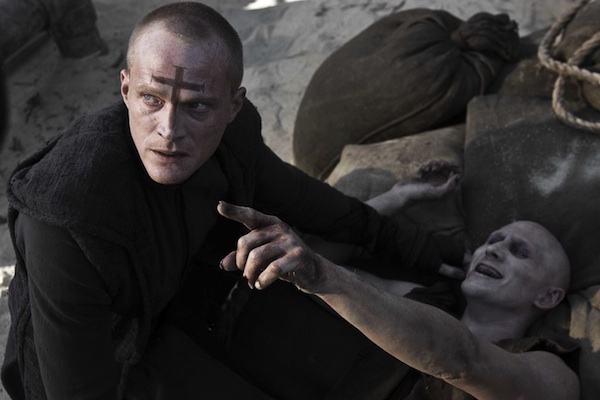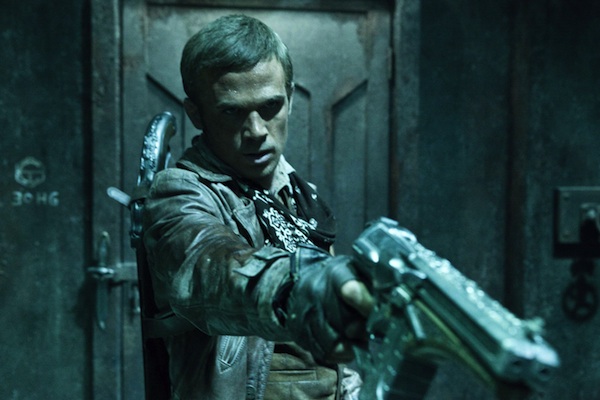|
International
audiences
continue to be fascinated by vampire lore and the recent spate of
vamp-as-romantic-hero
texts is a testament to this: Twilight,
The Vampire Diaries, True Blood.
How will a film like Priest, which traditionally
depicts
vampires as soulless villains, fare in this
Edward-versus-Jacob-obsessed world?
It’s hard to tell. Priest is
loosely based on Min-Woo
Hyung’s series of Korean graphic novels of the same name. It tells the
story of
an anonymous priest (Paul Bettany – The
Da Vinci Code, A Knight’s Tale) who,
along with many others, may wield the power of God. These gifted
citizens are
divine soldiers and are the only ones equipped to defeat the barbarous
vampires.
After years of peace, the priests are left religiously unemployed.
However,
when vampires kidnap a young woman, Bettany’s character must rebel
against the
Clergy and reprise his vamp-killing ways to rescue her.

With
Priest, vampires are portrayed as
eyeless and unsympathetic alien-like creatures. They live in
self-constructed
hives and have their own social hierarchy, with a Queen who presides
over four-legged
drones and workers. Through an animated opening sequence, we’re told
that humankind
and vampires have fought for resources and warred for survival since
the
beginning of time. But with violent events occurring in Afghanistan at
the
moment, one can only think, ‘What about a human-vampire truce?’ A
rebuttal to
this suggestion might be, ‘Well, those vampires lack empathy. They’re
just wild
carnivores that must be eradicated.’ I have only one response to this.
There
was once a time when humans and wolves similarly competed in the wild.
However,
our species was intelligent enough to domesticate and breed certain
wolves into
loyal ‘best friends.’ So, why hasn’t anyone in this world of Priest captured and tamed, or even experimented
on any vampires? It’s a legitimate question that weakens the logic of
the film
and, perhaps, graphic novels.

On
another film-bashing
note, the distinction between good and evil in Priest
is very claustrophobic. Humans are morally varied, but all vampires
are evil. This whole idea of slapping the ‘bad’ label on all things
alternative
is antiquated. It just reminds me of John Wayne and his
shudder-inducing role in
The Searchers. In this film, Wayne gathers
frontiersmen to reclaim his niece, who has been kidnapped by
Comanche’s. Of
course, these Native Americans are ‘all’ savage and uncivilised, and
must learn
their place in the colonised world.* These political
narrative
holes in Priest are not the only factors
that work against the film. Sure, it boasts exciting 3D visual effects
and fight-scenes
but the acting is very two-dimensional. For example, Cam Gigandet (Twilight, Easy A) is flat as Sheriff
Hicks. His previous role as a vampire may have been a studio tactic to
entice the
millions of Twi-Hards into cinemas. However, with his corny dialogue
and stiff
Zoolander-esque expressions, he is an artistic disservice to the film.
Perhaps
my discontentment
with Priest stems from the fact that
I’m reading it in secular terms – something that both the film and
graphic
novels are not. Much like director Scott Stewart’s previous feature Legion, Priest is full of Christian
references and symbology, with crucifix-shaped
ninja stars and voice-activated confessional booths. I just hope that,
with the
sequel (if one is made), there’s more insight into the vampires’
perspectives
and ideologies. After all, for a highly organised species, vampires
must have
their own sophisticated forms of communication à la bees and ants. I
certainly wouldn’t
mind subtitles. For better or worse, Priest is
the type of Hollywood
blockbuster that will sell through the roof. Champagne showers are
probably
pouring for Tokyopop and Screen Gems as I type. However, if I’d wanted
to watch a graphic sci-fi vampire film with characters that rebelled
against a
futuristic autocracy, I would have stuck with the forward-thinking Underworld.
*After
writing this review, I was shocked to discover
that Priest is indeed a tribute to The
Searchers. Double Yuck!
|